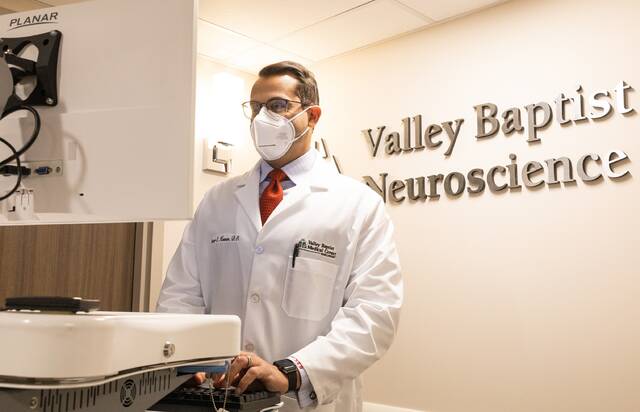|
Only have a minute? Listen instead
Getting your Trinity Audio player ready...
|
HARLINGEN — Time is money.
Time is life, time is of the essence, time is the winning of a race.
And… it is brain power.
When a stroke hits the brain, two million neurons die each minute.
This means that time is crucial, time is everything, time and speed mean the difference between permanent disability or a return to normal activities.
That’s why the neurosurgeons at Valley Baptist Medical Center-Harlingen, and indeed throughout the world, are now using artificial intelligence to increase the speed in which strokes are treated.
“Artificial intelligence is not just keeping pace but staying two steps ahead in managing complex stroke cases,” said Dr. Ameer Hassan, head of the neuroscience department at VBMC.
“By rapidly analyzing brain imaging results, AI alerts healthcare teams to critical changes, allowing for quicker diagnosis and interventions,” Hassan said.
The AI technology which the neuroscience department has been using to improve patient outcomes is Viz.ai, a cloud-based app which physicians carry on their phones. The app leverages AI to speed up stroke diagnosis and treatment. The app does this by automatically analyzing CT scans and alerting the appropriate medical professionals immediately.
A CT scan creates three-dimensional images of internal organs, soft tissues, blood vessels and bones. It provides a more detailed image than the traditional x-ray.
Valley Baptist has utilized AI to provide more accurate diagnoses and reduce response times for large vessel occlusion strokes, which are caused by the blockage of a major artery in the brain, Hassan said. This blockage leads to significant areas of the brain being deprived of blood and oxygen which can cause extensive damage.
“The AI system analyzes CT angiograms to detect large vessel occlusion strokes and instantly notifies all relevant team members, facilitating swift and coordinated care,” Hassan said. “Our findings underscore significant improvements across our hub and spoke model even at our comprehensive stroke center. These enhancements are crucial since every minute counts in stroke treatment.”
Valley Baptist Medical Center in Brownsville is also using the technology.
“The use of artificial intelligence at Valley Baptist-Brownsville allows neurologists to make rapid decisions related to a patient’s treatment,” said Dr. Luis Gaitan, medical director of the stroke program there.
“Patients suspected of having a stroke receive imaging upon their arrival to the hospital, and neurologists are able to see those scans immediately on their phones or computers,” he said. “The artificial intelligence will alert neurologists to take immediate action when it detects a large vessel occlusion in those images, which is so important because when dealing with stroke, time is brain.”
Valley Baptist has now broadened its AI capabilities to address not only LVOs but also intracerebral hemorrhaging. This is the most common type of hemorrhagic stroke, and it occurs when an artery in the brain bursts, flood the surrounding tissue with blood, Hassan said. This buildup of blood puts increased pressure on surrounding brain cells and can lead to long-term disability and death.
Significant outcomes from AI integration
Recent studies conducted by Valley Baptist have demonstrated that AI integration not only speeds up treatment times but also enhances patient outcomes. Findings presented at the American Heart Association’s International Stroke Conference highlighted several benefits:
>> Decreased patient transfer times.
>> Expedited treatment processes.
>> Reductions in hospital stays.




